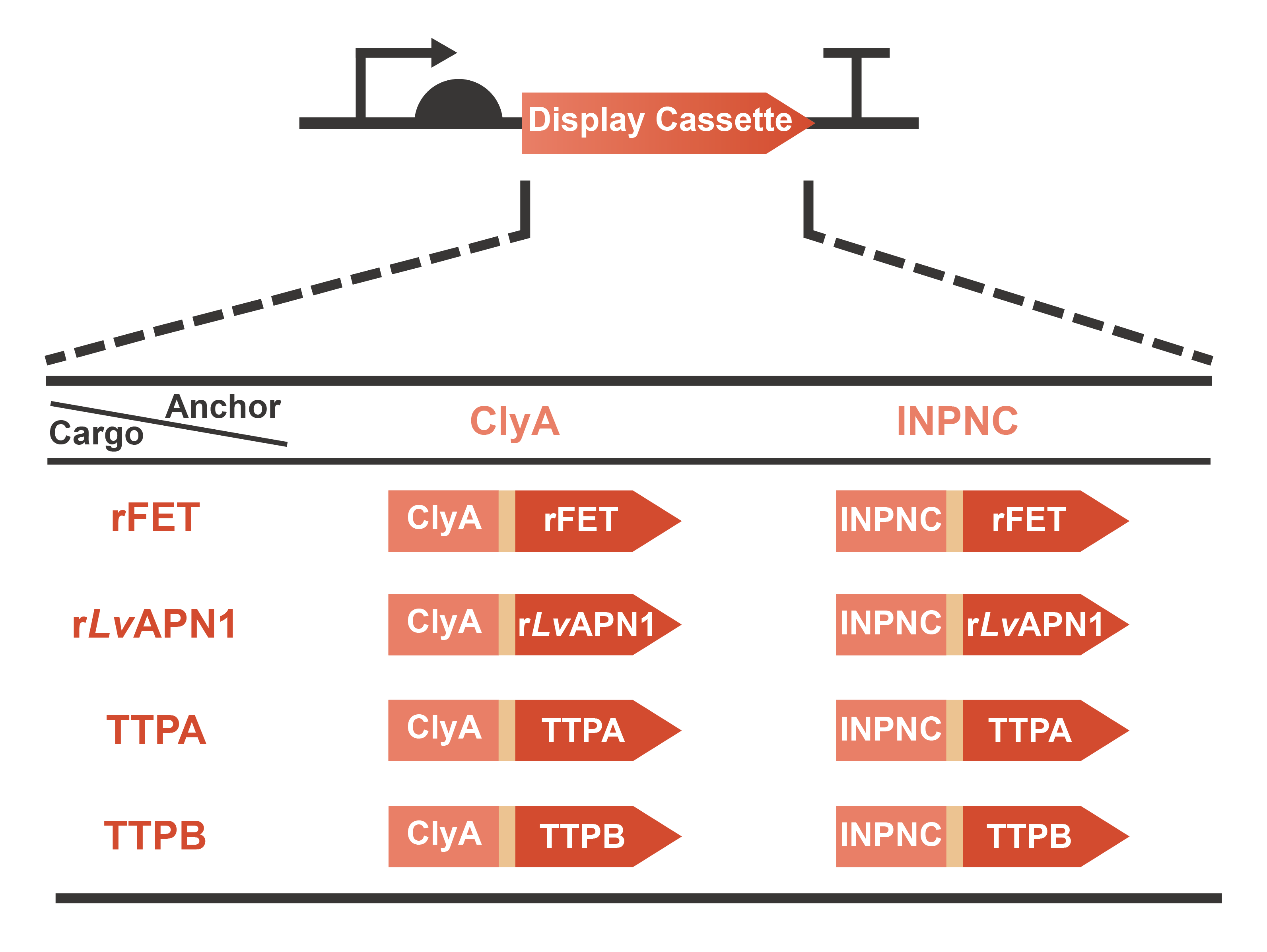Part:BBa_K4195125
I0500-B0034-INPNC-rFET-B0015
Usage and Biology
INPNC
INPNC is a truncated form of ice nucleation protein (INP) consisting of N- and C-terminal domains (1). It is a membrane protein commonly used to target protein onto the cell membrane.
rFET
rFET is a truncated form of the A chain of mouse fetuin-B (residues 141-169). Vertebrate fetuins are multi-domain plasma-proteins of the cystatin-superfamily (2). It was reported that mouse fetuin-B shows high inhibition effect to the toxin PirB (3). We used the ClusPro (4) to evaluate the affinity of mouse fetuin-B to PirA and PirB. The results showed that the 141-169 residues of the A chain of mouse fetuin-B have higher affinity to PirA and PirB than the complete A chain of mouse fetuin-B. What’s more, there is no glycosylation site in rFET sequence, so the expression of recombinant rFET by engineered E. coli can be available and functional. In summary, we chose the 141-169 residues of the A chain of mouse fetuin-B as the functional inhibitor and named it rFET (BBa_K4195009).
The rFET can be displayed on the surface of the engineered bacteria and OMVs (outer membrane vesicles) due to the localization of INPNC. The OMVs with rFET displayed is more stable in the environment than rFET and is a better choice for binding to toxins.
Usage and design
Engineering OMVs for treating and preventing AHPND caused by the pathogen V. parahaemolyticus are a significant part of OMEGA project (Operable Magic to Efficiently Getting over AHPND). Based on the efforts of our previous projects in 2020 (AnTea-Glyphosate) and 2021 (SALVAGE), we further developed the surface display system on the OMVs released by the engineered bacteria. The usage of cargo proteins was no more limited to enzymes that are usually utilized to catalyze series bio-chemical reactions, since some receptors or ligands involved in complex protein-protein interaction (PPI) were selected as the cargo candidates. This year, we chose two classic anchor proteins, ClyA and INPNC, to construct the display cassette with various cargo proteins including rFET (receptor), rLvAPN1 (receptor), TTPA (ligand) and TTPB (ligand) (Fig. 1). On one hand, with the receptors displayed, OMVs will gain the function of neutralizing toxins secreted by V. parahaemolyticus. On the other hand, with the assistance of ligands displayed on the surface, OMVs will become a special vector to deliver antimicrobials for the specific pathogen. In summary, we have taken a step closer to the collections of extracellular functional elements (EFE), combining the OMVs, secretion systems and surface display systems which we have been dedicated to since 2020. Learn more information from our Designpage.
Fig. 1 Graphic description of the expression gene circuits for display cassette designed in OMEGA project.
This composite part was constructed at pSB1C3 to express INPNC-rFET (BBa_K4195024), which is induced by L-arabinose. We transformed the plasmid into E. coli BL21(DE3) for further verification of its expression and function on the surface of E. coli and OMVs, including the interaction between rFET and PirA and PirB toxins.
Characterization
1. Identification
When constructing this circuit, colony PCR and gene sequencing were used to verify that the transformants were correct. Target bands (2484 bp) can be observed at the position between 2000 bp and 3000 bp (Fig. 2).
Fig. 2 DNA gel electrophoresis of the colony PCR products of BBa_K4195125_pSB1C3.
2. Ability of binding PirB on the surface of engineered bacteria
The arabinose-induced overnight culture was then incubated with purified his-PirB and FITC-labeled anti-His-tag antibody in turn to verify whether the displayed rFET could bind his-PirB or not.
Fig. 3 The results of immunofluorescence to probe the binding event on the surface of engineered bacteria (p = 0.0426).
The ratio of fluorescence intensity (λEx = 492 nm, λEm = 518 nm) to OD600 of positive control (culture was incubated with his-PirB) is higher than that of negative control (culture was incubated with 1×TBST) (Fig. 3), which indicates that our surface display system works well and the binding ability of rFET to PirB is retained on the surface of bacteria.
Sequence and Features
- 10COMPATIBLE WITH RFC[10]
- 12INCOMPATIBLE WITH RFC[12]Illegal NheI site found at 1205
- 21INCOMPATIBLE WITH RFC[21]Illegal BamHI site found at 1144
- 23COMPATIBLE WITH RFC[23]
- 25INCOMPATIBLE WITH RFC[25]Illegal NgoMIV site found at 1641
Illegal NgoMIV site found at 2200
Illegal AgeI site found at 979
Illegal AgeI site found at 1743
Illegal AgeI site found at 2059 - 1000INCOMPATIBLE WITH RFC[1000]Illegal SapI site found at 961
| None |



